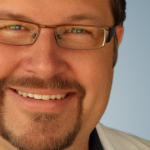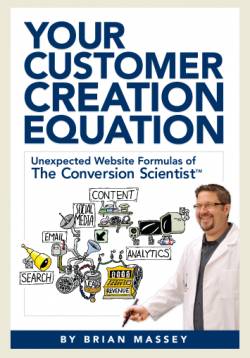
Brian Massey, The Conversion Scientist & Author of "Your Customer Creation Equation"
An effective landing page optimization program can have a profound impact on your organization's bottom line. In fact, according to data from landing page optimization vendor ion interactive, 73% of their customers that create and test landing pages achieve 100% lift in their conversion rate. Amazing, right?
Data doesn't lie, but I've also seen first-hand how simply creating and testing targeting landing pages can impact digital marketing performance, so I'm thrilled that Brian Massey, the
Conversion Scientist and author of Your Customer Creation Equation, is joining us next Thursday, February 22 for an interactive, online workshop on landing page success. I have seen Brian present many times (both in-person and online), and he is by far one of my favorite instructors on digital and conversion marketing. This will be an informative AND fun virtual workshop that you don't want to miss.
To give you a sneak peek of next week's workshop, I interviewed Brian and asked him for his best advice on landing page optimization. Here's what he had to say:
1. What are some of the most common landing page mistakes marketers make?
The first and most damning is to start their landing page with the template of their corporate website. It typically adds a whole bunch of distractions and opportunities to abandon. Navigation, social media links, a logo that links to the home page, alternative offers and more columns than is needed all contribute to clutter and distraction.
I say start with a clean page.
2. What are the top 5 elements of an effective landing page?
Start with a landing page. Blank is preferred. Add an offer and some way to take action, a button or form is typical. To overcome the abandonment, slather on persuasive copy. Show the product with an image.
Add some trust symbols, sprinkle in some proof, and, voila! You have a landing page.
I’ll be talking about these components in my workshop in more detail.
3. What makes a great landing page headline?
First, it should keep the promise made by the ad, link or email that brought the visitor to the page. If you offer 15% off in the ad, the landing page needs to restate the 15% off offer again. This is a great use of the headline.
Second, it should promote the offer with a payoff or promise. If you’re offering a white paper, don’t pick a headline that talks about your product or company. It should pimp the white paper. “The guide that shows you how to deliver great results” might be a good headline template for a white paper.
4. How many calls-to-action should you include on a landing page?
One and a half at most.
5. What makes a great call-to-action?
Tell the visitor they’re going to get something they want or need. Take as much space as you like.
6. How long should landing page copy be?
As long as is needed and no longer. Methodical visitors scroll, and can’t take action until they already know most of the answers. Give it to them.
For quick-deciding visitors, give them the summary at the top, above the fold. But don’t design just for them.
7. What is the most important piece of advice you can give to marketers that need to improve their conversion rate?
Make time. When a marketer is short on time, they either create messages that they like, or create messages that won’t get pushback from the boss. In both cases, the messages are targeted inwardly, not at the visitor.
Make time to be curious. Give yourself the time to write down the ten things that you think your visitors would prefer.
Make time to be deliberate. Budget for the extra time and creative to try two versions of your ads, pages, and informational offers.
Make time to review. Take the time to look at your analytics, test results, customer feedback, reviews and hate mail. Learn from the data you can and already are collecting.
Make time to educate. Be the “Cheerios Guy” of your company. Brag about your successes. Help your extended team understand the value of the extra work you’re doing. Be the expert.
Make time to learn. Have you read the books? Have you scanned the blogs? Have you taken that course? Have you been to the conferences? A career in marketing is a lifestyle. Choose your lifestyle and live it fully.
Make time.
8. Copy vs. design? What do you think is more important?
Both are important. Copy is the offer, proof, and call to action used on the page. It can be delivered by words, images and video.
Design is the way the placement, font, color, and whitespace guide the eye.
I’ve seen too many “ugly” pages win in tests to believe that a designer has enough tools to overcome a bad offer or copy. We’ve been able to find success with changes to words, headlines and copy.
So, I’m a copy-first kind of scientist. Get the messages right and a competent designer can turn them into a high-converting page or site.
9. What are your favorite elements to test?
My favorite element to test is Gold (commonly known as Revenue). I like to see how much of it we can generate from a given amount of Traffite (common name: Traffic).
Youranium is one of my favorites. It’s radioactive and infects everything on the page. It influences the copy and images you choose on the destination. It can be found by understanding your visitors. It eliminates Melium (an inert gas). It decays into Trustanium.
I also like testing Headlinum, commonly known as “Headline.” It’s a great predictor of who will read the site and who will not.
Formite is used to create forms. Understanding which form fields will scare away unqualified leads and which will scare away qualified leads is very important, and takes some experimentation.
Textosterone is another favorite, though it’s not technically an element. Copy will make or break an ad, landing page or microsite.
10. When starting a testing program, where do you begin?
We always start with what you know. Slap some analytics on the site and see what your visitors can tell you with their actions. Quiz the sales staff to see what triggers a customer to call or visit. Apply what we’ve learned from other’s tests to a site and see if there are opportunities to improve it.
All of this leads to a hypothesis list. When vetted and ranked, it provides a program for optimizing a site to high conversion rates and higher revenue per visit.
BONUS QUESTION! How did you get started in conversion optimization?
What else would a Computer Scientist with Sales and Marketing experience who ran his own company do?
I wrote my own analytics package in 1999-2001 (Open Source Online Marketing).
I learned when running my Web development company that traffic wasn’t enough.
My sales experience taught me how to listen to the customer, so it was natural to apply that to visitors.
My marketing experience didn’t hurt me enough to make a difference
I was heavily influenced by Bryan and Jeffrey Eisenberg, who taught at a unique business school near Austin called The Wizard Academy.
Given all of this, there was no choice but to become a Conversion Scientist.
